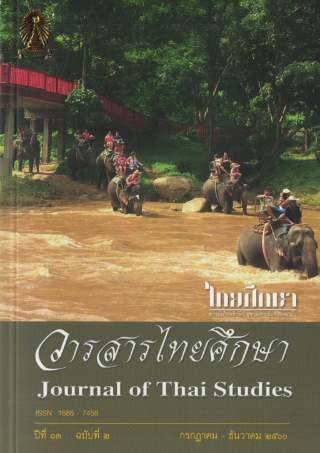Garuphan: 1000 Holy Objects and Functions in Isan Culture
Main Article Content
Abstract
The Kharuphan are holy objects of the Buddhism culture in central Isan. Almost all temples in Kalasin and Roi-Et provinces have the Kharuphan. In the past, the Kharuphan was created to hold a variety of items, such as various kinds of lotus, rolled betel nuts and leaves, flowers of different kinds and rolled cigarettes used in the Mahachat Sermon of the fourth month. They were used as offerings for 1,000 khatha.
At the Mahachat Sermon Festival or Bunphawet in central Isan, a monk or an elderly man had to place a Kharuphan, one or two pairs of them. When the ceremony ended, all of the temples would place the Kharuphan on their altar table set. Now the Kharuphan have been used as protective charms in Isan rituals, including family rituals, such as the evening prayer and the house warming ceremony, as well as community rituals, such as pan-fried sticky rice ceremony (Bun Khao Ji), Bun Khum or Bun Boek Ban, and the rocket festival (Bun Bang Fai). The Kharuphan is mainly used as protective charms against inauspicious events that might occur during the ceremony. Another role of the Kharuphan is to represent offerings for the Mahachat Sermon, since offerings items are hard to find in some years, such as flowers, betel nuts and leaves, lotus and Sabang flowers.
In addition to the role as a protective charm in rituals, Isan people respect the Kharuphan like Phra Upagutta or monks. This is so because the Kharuphan is placed on an altar table along with Buddha images, although placed below the Buddha image. In addition, the Kharuphan is usually kept at the seat of a temple’s abbot. Hence, the Kharuphan in Isan culture is not only an object for a Buddhist ceremony, it is also a sacred object that has the same role as Phra Upagutta that needs to be enshrined in the ceremonies. It has the same status as a revered monk and as an abbot, as well as the same status as an amulet.
Downloads
Article Details

This work is licensed under a Creative Commons Attribution-NonCommercial-NoDerivatives 4.0 International License.
Journal of Thai studies is licensed under a Creative Commons Attribution-Noncommercial-NoDerivatives4.0 Intenational (CC BY-NC-ND 4.0) licence, unless otherwise stated. Plese read our Policies page for more information on Open Access, copyright and permissions.
References
ธนิต อยู่โพธิ์. (๒๕๑๔). ตำนานเทศน์มหาชาติและแหล่เครื่องเล่นมหาชาติบางแหล่. พระนคร: ศิวพร.
วิมลพรรณ ปีตธวัชชัย. (๒๕๑๖). ฮีตสิบสอง. กรุงเทพฯ: มหาชน.
อริยานุวัตร, พระ. (๒๕๐๖). ระเบียบโบราณประเพณีทำบุญ [มปท.]
ภาษาลาว
วีรจิตตะมหาเถระ [สาทุใหญ่คำจัน วีระจิต], พระ. (๑๙๙๑). มาลัยแสน. ม.ป.ท.
เอกสารใบลาน
มาลัยแสน. ใบลานอักษรธรรมอีสาน ภาษาอีสาน ฉบับพ่อดำ สรรค์สมบัติ บ้านทุ่งโปร่ง อ.อุบลรัตน์ จ.ขอนแก่น จำนวน ๑ ผูก
สัมภาษณ์
เกษมบุญสิริ, พระครู. (๑๕ มกราคม ๒๕๖๐). สัมภาษณ์. เจ้าอาวาสวัดทักษิณ ต.บ้านโสก อ.คอนสวรรค์ จ.ชัยภูมิ.
เทพสารเมธี, พระ. (๑๙ มีนาคม ๒๕๕๙). สัมภาษณ์. เจ้าอาวาสวัดประชานิยม เจ้าคณะจังหวัดกาฬสินธุ์ (ธรรมยุติ) จ.กาฬสินธุ์.
ประมวล อธิปญฺโญ, พระอธิการ. (๑๒ มีนาคม ๒๕๕๙). สัมภาษณ์. เจ้าอาวาสวัดโกกกลาง อ.พนมไพร จ.ร้อยเอ็ด นิสิตมหาวิทยาลัยมหาจุฬาลงกรณ์ สาขาวิชาพระพุทธศาสนา วิทยาลัยสงฆ์ร้อยเอ็ด.
ปริยัติธรรมวัตร, พระครู. (๒๑ มีนาคม ๒๕๕๙). สัมภาษณ์. นิสิตมหาวิทยาลัยมหาจุฬาลงกรณ์ สาขาวิชาพระพุทธศาสนา รองเจ้าคณะอำเภอศรีสมเด็จ จ.ร้อยเอ็ด.
วิชัยกิตติคุณ, พระครู. (๑๖ ธันวาคม ๒๕๕๙). สัมภาษณ์. อดีตเจ้าคณะอำเภอกันทรวิชัย อายุ ๘๑ ปี เจ้าอาวาสวัดสุวรรณมงคล บ้านคันธา จ.มหาสารคาม.
วิจิตร อาจคำไพร. (๑๙ มีนาคม ๒๕๕๙). สัมภาษณ์. ทายกและหัวหน้าอุบาสกอุบาสิกา อ.พนมไพร จ.ร้อยเอ็ด
สัมฤทธิ์ มุขภักดี. (๓๑ มีนาคม ๒๕๕๙). สัมภาษณ์. ไวยาวัจกรวัดสว่างเหล่าอ้อย อายุ ๗๕ ปี ต.เหล่าอ้อย อำเภอร่องคำ จ.กาฬสินธุ์.
สิทธิวโรภาส, พระครู. (๒๐ เมษายน ๒๕๕๙). สัมภาษณ์. เจ้าอาวาสวัดท่าสะแบง รองเจ้าคณะอำเภอทุ่งเขาหลวง จ.ร้อยเอ็ด.


